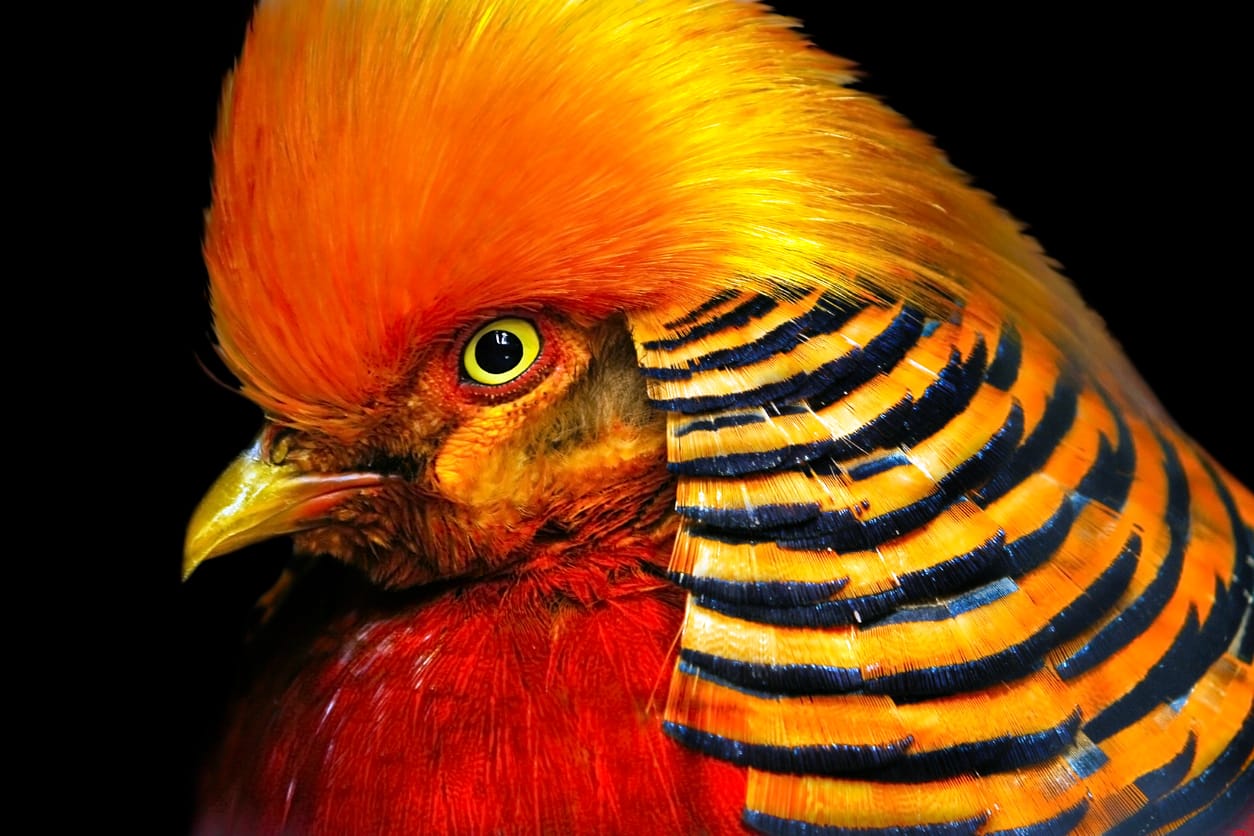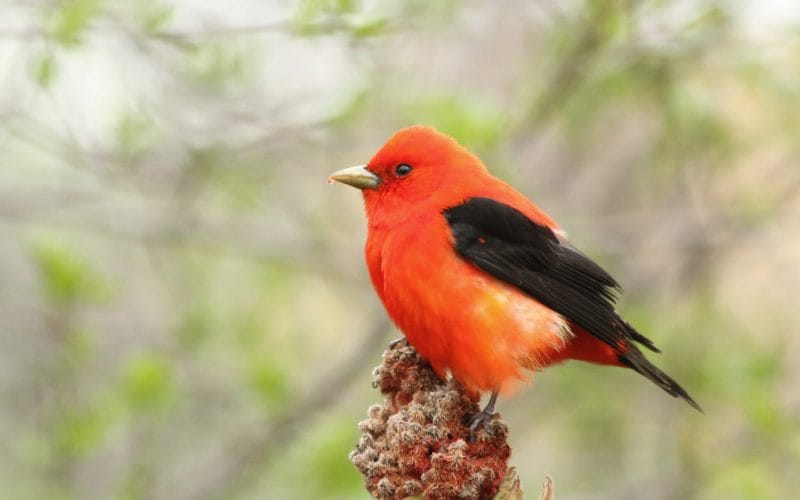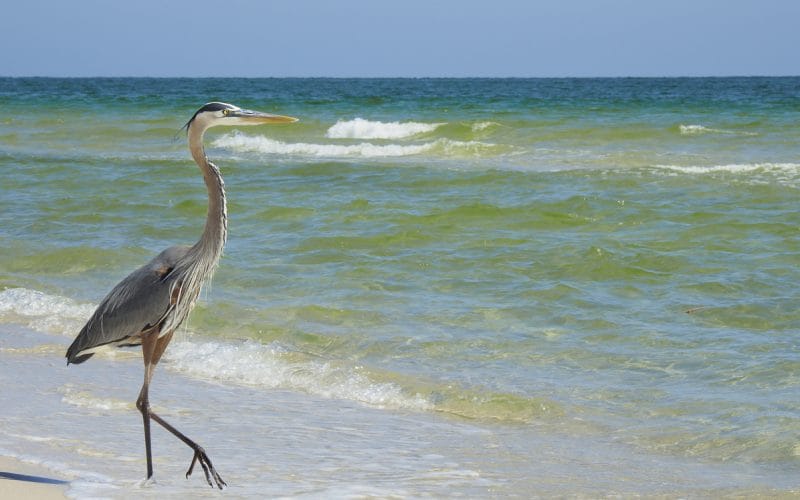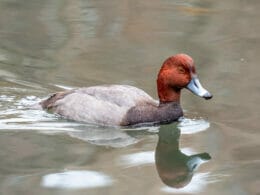For us humans, mohawks are a fashion statement. Depending on how it’s styled, it can either be elegant and dapper or rebellious and daring.
For birds, it’s a different story. Birds use their mohawks (or crests, as they’re more commonly called in the bird community) to communicate and defend themselves. The mohawks make them appear larger and more intimidating than they actually are!
There’s a surprising number of birds with mohawks out there. If I were to list them all, I’d be here all day!
Instead, I’ve selected some of the most majestic of the bunch—the ones that pull off the mohawk look perfectly.
Let’s dive right in!
Top 14 Beautiful Birds with Mohawks
1. Golden Pheasant

- Scientific name: Chrysolophus pictus
- Length: 35 to 41 inches
- Weight: 20 to 22 ounces
- Wingspan: 28 inches
Alluring and elegant, the Golden Pheasant looks like it came straight out of Ancientian Egyptian scripts.
It has bright red underparts, a light orange ruff, a green upper back, and a golden-yellow rump. Its golden “mohawk” is tipped with red and extends from the top of its head down its neck. Everything about it says, “worship me!”
Author Note: Also known as the Chinese Pheasant, this eye-catching sight inhabits the mountainous forests of western China, as well as North and South America, and Australia. It’s also sometimes found in certain parts of western Europe.
The Golden Pheasant is among the many endangered and protected species of China.
2. Pileated Woodpecker
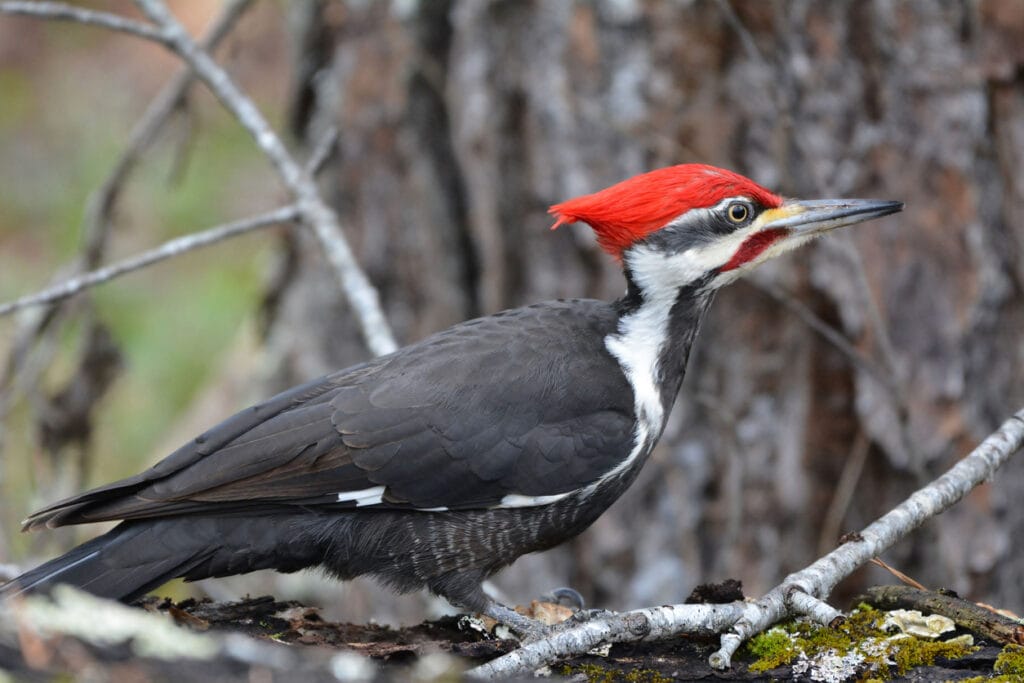
- Scientific name: Dryocopus pileatus
- Length: 16 to 19 inches
- Weight: 9.8 ounces
- Wingspan: 26 to 30 inches
There are over 180 woodpecker species out there, but the Pileated Woodpecker is certainly one of the more recognizable with its black and white stripes and flaming-red mohawk.
As the largest woodpecker species in North America, the Pileated Woodpecker is one of those cool-kid-on-the-block types: flashy and loud, but well-loved by other species.
Its feeding excavations are so deep and thorough that it often attracts other birds wanting to feed, like House Wrens and European Starlings.
Primarily feeding on insects and wild fruit, the Pileated Woodpecker can be found in mixed and mature deciduous-coniferous woodlands across the globe.
3. Victoria Crowned Pigeon
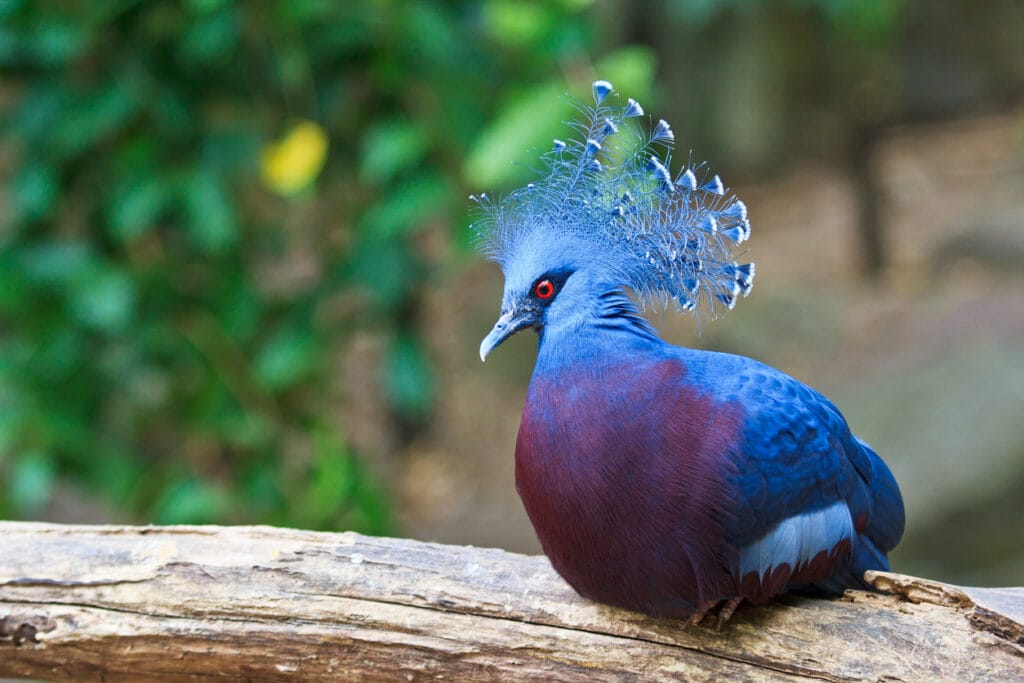
- Scientific name: Goura victoria
- Length: 24 to 29 inches
- Weight: 88 to 123 ounces
- Wingspan: 24 inches
Named after British monarch Queen Victoria, the Victoria Crowned Pigeon is beauty personified.
With its eye-catching bluish-gray plumage, elegant lace-like crest, and striking red irises, this crowned pigeon is not only one of the rarest birds in the world but also the largest surviving species of its kind.
Classified as Near Threatened (NT), there are only around 10,000 to 20,000 of these birds left. They mostly reside in the lowland and swamp forests of Papua New Guinea and Indonesia.
4. Palm Cockatoo
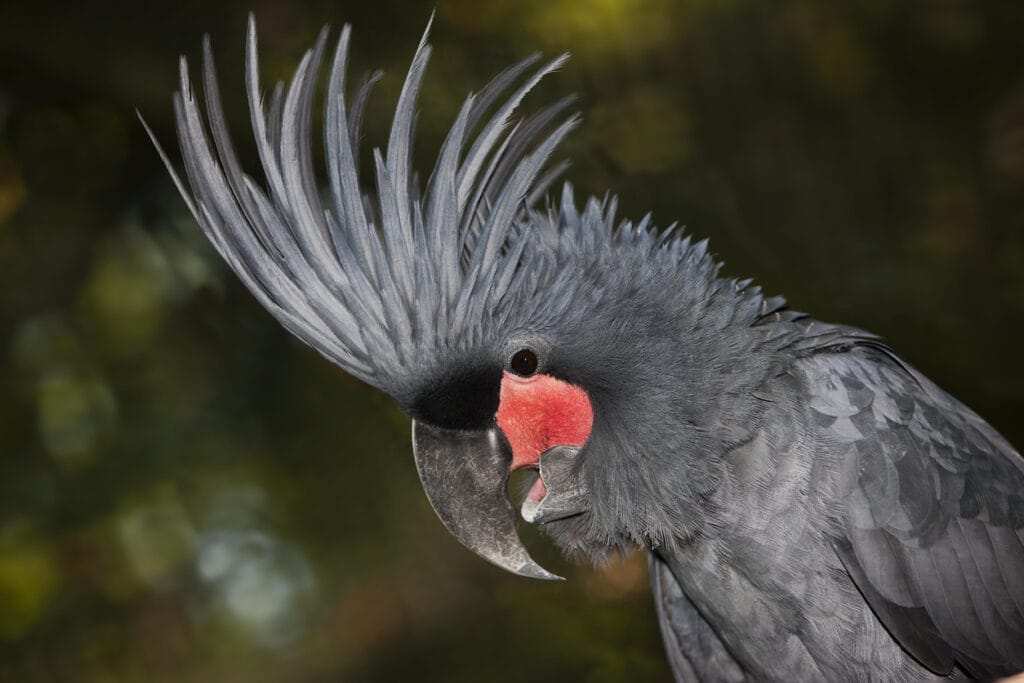
- Scientific name: Probosciger aterrimus
- Length: 19 to 27 inches
- Weight: 16 to 32 ounces
- Wingspan: 27.5 to 39 inches
The Palm Cockatoo not only looks like a rockstar with its prominent mohawk-like crest; it actually IS a rockstar! It’s the only bird in the world that uses a tool musically, which is why it’s often called “The Drumming Bird” or the “Ringo Starr.”
Top Tip: The Palm Cockatoo is a large, black, or smoky gray parrot with a larger-than-usual black beak and prominent red cheek patches.
Found throughout New Guinea and Australia, the Palm Cockatoo is unfortunately threatened with extinction, following the recent 2020 bushfires in far north Queensland.
Currently, there are fewer than 2,000 species living in the wild.
5. Sulphur-crested Cockatoo
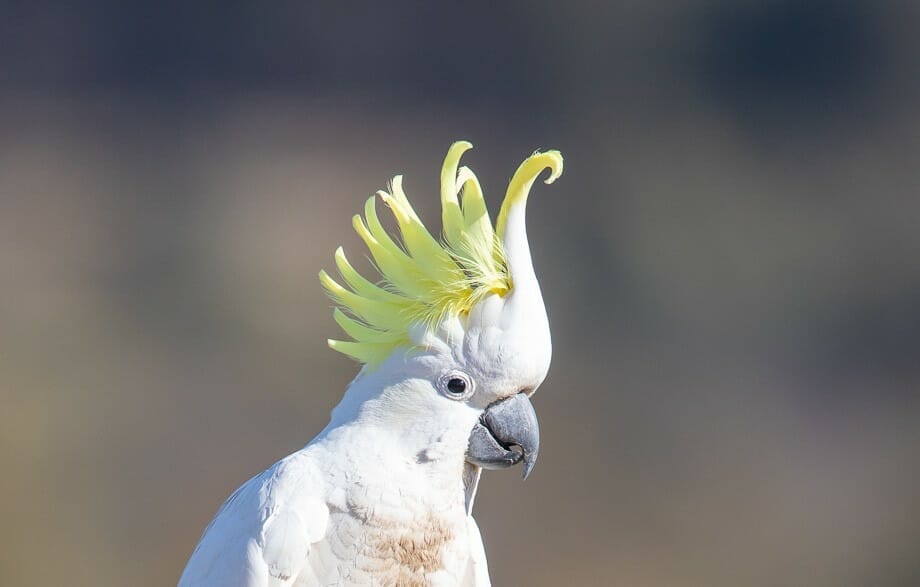
- Scientific name: Cacatua galerita
- Length: 17.5 to 21.5 inches
- Weight: 24.5 to 33.3 ounces
- Wingspan: 38 to 40 inches
Found in wooded habitats of New Guinea, Indonesia, and Australia, the Sulphur-Crested Cockatoo is one of the largest white cockatoo species in the world.
The Sulphur-Crested Cockatoo shares a striking similarity with the Yellow Crested Cockatoo, except its 35% larger overall and lacks the distinct yellow coloring on its cheeks.
This rockstar got its name from its striking sulphur-yellow crest. It’s one of the more expensive parrot pets in the US, costing anywhere between $2,000 to $4,000 depending on the reputation of the breeder.
As a pet, the Sulphur-Crested Cockatoo is loud, needy, and kind of high-maintenance.
It has its upsides, too, though; it’s social, affectionate, and incredibly intelligent.
Furthermore, it’s a long-lived species. If well taken care of, it can live up to 80 years!
6. Eurasian Hoopoe
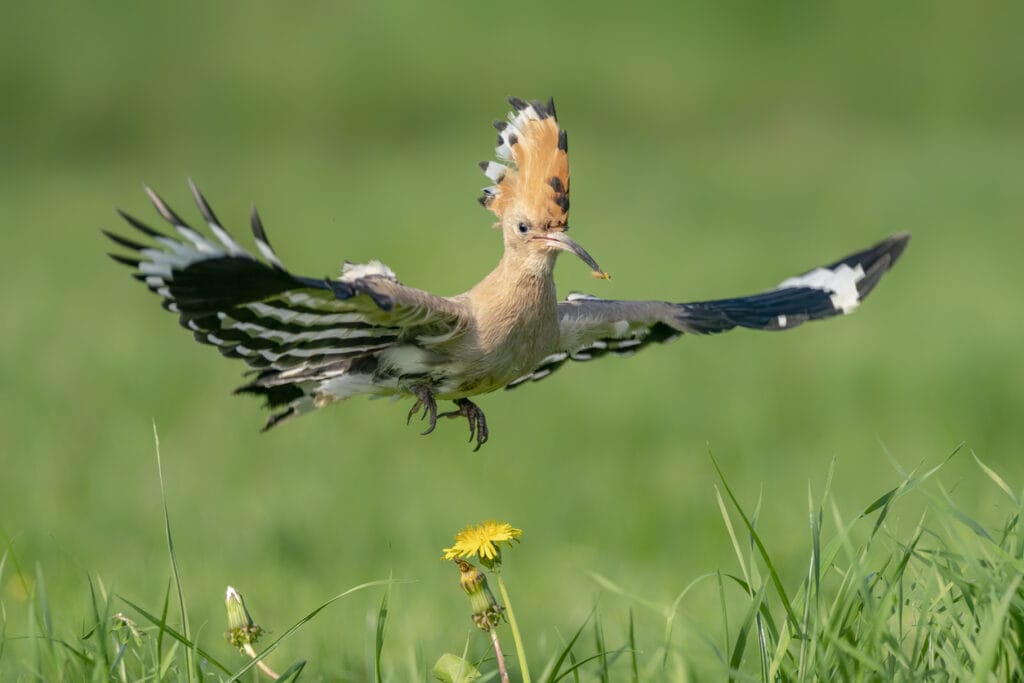
- Scientific name: Upupa epops
- Length: 9.8 to 12.6 inches
- Weight: 1.6 to 3.1 ounces
- Wingspan: 17 to 19 inches
Eurasian Hoopoe are one of the world’s most eye-catching bird species. They’re quite common in Europe, Asia, and the northern half of Africa, but they’re also sometimes spotted in North America. This makes them the most widely distributed species in the genus Upupa.
Known for their black-tipped ornamental mohawks, Eurasian Hoopoes are a sight to behold. They look like they came out of a fashion magazine with their black-and-white patterned wings and soft red-orange chests and face.
As the most common species in the hoopoe family, Eurasian Hoopoes often appeared in the folklore of many cultures in human history. From Ancient Chinese texts to Egyptian hieroglyphics, they’re always mentioned one way or another. With their striking patterns, it’s not difficult to see why!
7. Crested Partridge
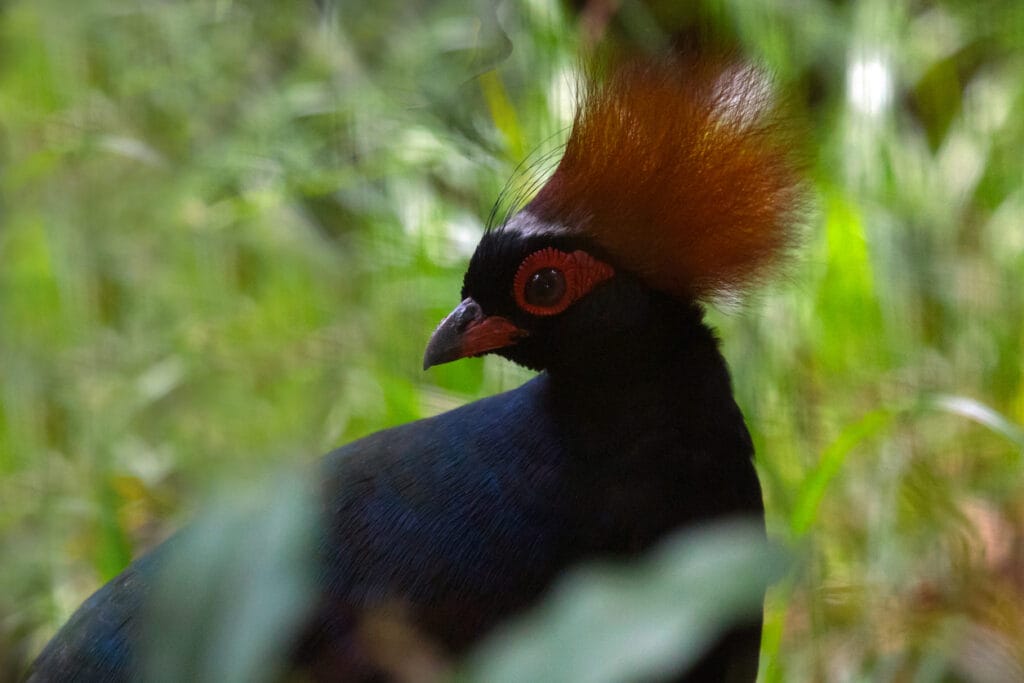
- Scientific name: Rollulus rouloul
- Length: 9 to 11 inches
- Weight: 6.5 to 21 ounces
- Wingspan: 5 inches
Roll the red carpet, everyone—the Crested Partridge is up next!
This adorable round bird is filled to the brim with personality and style.
It has a fluffy red mohawk, a white forecrown, a red patch over the gape of the upper mandible, and a bright red ring around its eyes.
Its head-to-face ratio is almost comical, with its face being way smaller than its body, but the Crested Partridge somehow pulls it off.
Author Note: The Crested Partridge lives in the lowland rainforests of Malaysia, Borneo, Sumatra, South Burma, and South Thailand.
It was formerly widespread, but due to habitat loss, the species has undergone a rapid reduction in population.
Today, the Crested Partridge is listed under Vulnerable and Near Threatened.
8. Philippine Eagle
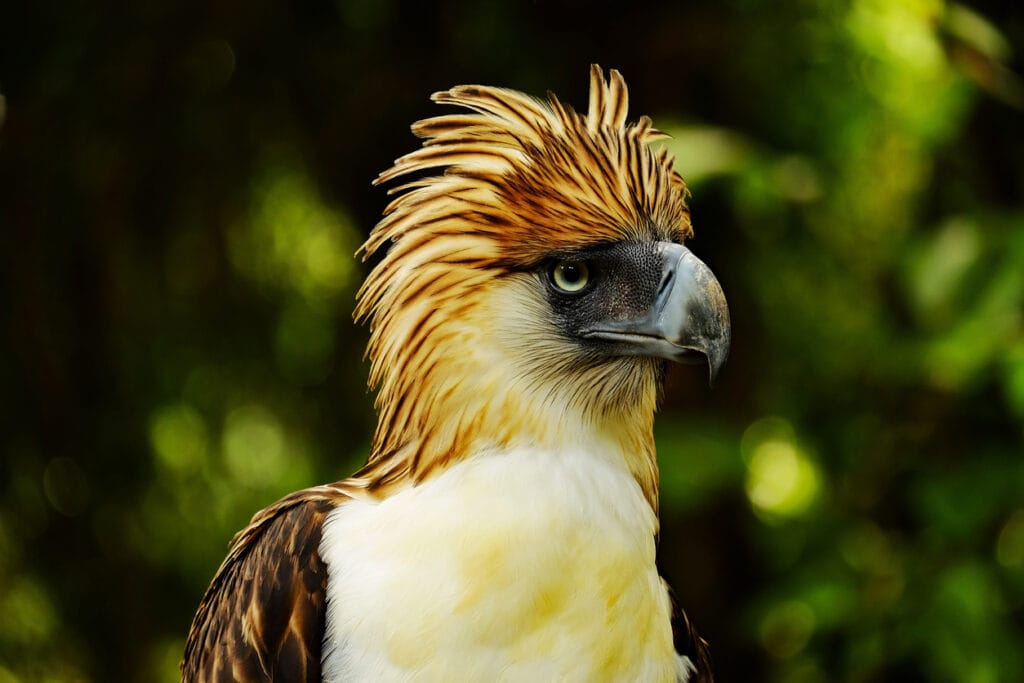
- Scientific name: Pithecophaga jefferyi
- Length: 36 to 42 inches
- Weight: 166 to 282 ounces
- Wingspan: 78 inches
Dubbed as the Philippine’s National Animal, the Philippine Eagle, AKA the Monkey-Eating Eagle, is one of the world’s most powerful birds of prey—and it shows. With its intimidating blue-gray stare and sharp hooked beak, this eagle shows no mercy during its hunt.
The Philippine Eagle has a shaggy mohawk with golden highlights, a dark face, a brown back, and a creamy-brown nape.
In terms of length and wing surface, the Philippine Eagle is considered the largest eagle in the world. It stands at around 3.5 feet tall and has a wingspan of up to 6.5 feet. In comparison, the Bald Eagle stands at 2.5 to 3 feet tall and has a wingspan of 6 feet.
This handsome heart-breaker is one of the rarest birds in the world, with less than 500 individuals left. They’re among the most globally endangered species, and also one of the world’s rarest birds of prey.
9. Crested Duck
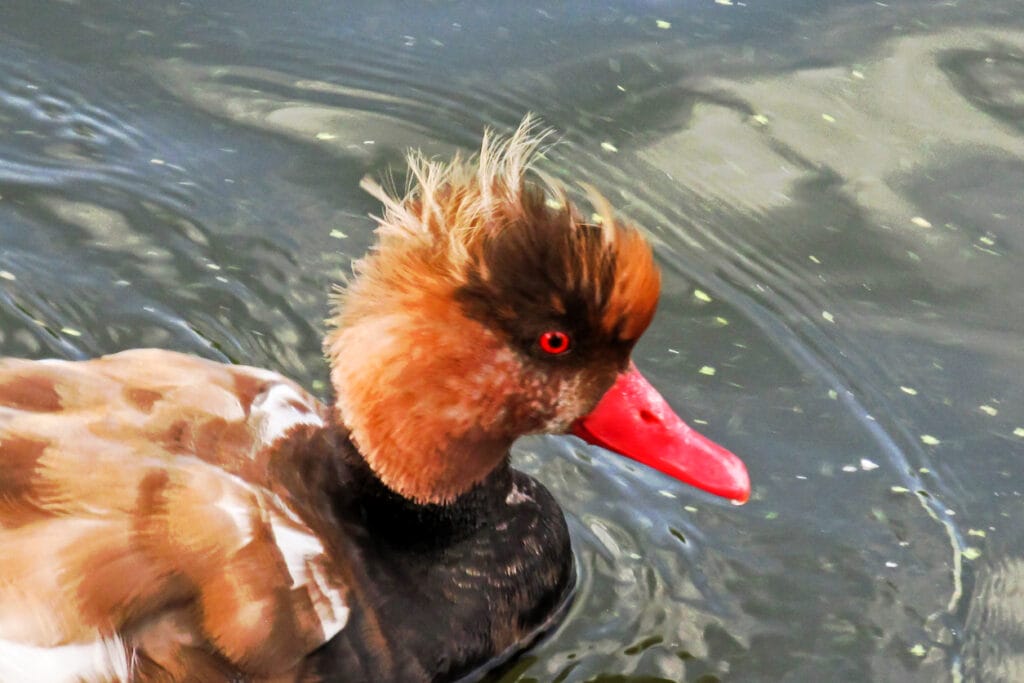
- Scientific name: Anas platyrhynchos domesticus
- Length: N/A
- Weight: 32 to 112 ounces
- Wingspan: N/A
Crested Ducks are one of the more recognizable species of ducks out there, especially since they have features that other duck breeds don’t have. Yes, I’m talking about their powder-puff mohawk, which looks like it was blow-dried and gelled to perfection!
This unique species is of unknown origins, but they’ve been around for ages—since before the 1600s! They were portrayed in several Dutch paintings around the 17th century and described in several ancient Greek texts.
Author Note: Although praised for its rockin’ appearance, the powder-puff mohawk is anything but natural. The crest is actually a genetic mutation caused by a skull deformity.
The “hair” grows out of a section of fatty tissue in between the gap of the duck’s skull. This causes serious health issues, such as neurological problems, seizures, and early death. They rarely live past the age of 10.
10. Red-crested Turaco
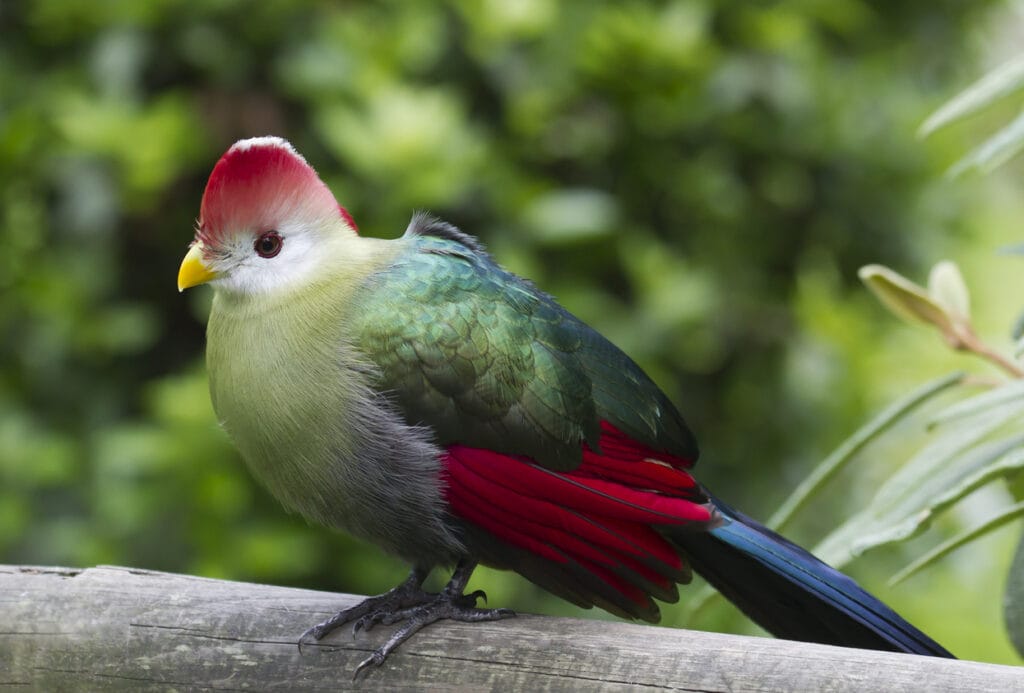
- Scientific name: Tauraco erythrolophus
- Length: 19 to 20 inches
- Weight: 5 to 8 ounces
- Wingspan: 19 to 25 inches
If birds attended high school, Red-Crested Turacos would absolutely belong to the drama club.
With their mostly green plumage, yellowish-green beaks, and red-rimmed brown eyes, they have a dramatic, Shakespearean look to them.
They’re the only species of birds that possess true green and red coloration. In fact, if you stirred a red turaco feather with water, the water will turn pink! This suggests that the pigments of this bird’s plumage contain traces of copper.
As the name suggests, Red-Crested Turacos have red crests on their heads. They’re mostly found in Angola’s subtropical and tropical forests, as well as moist lowlands. They’re rarely seen outside Angola in the wild.
11. Smew
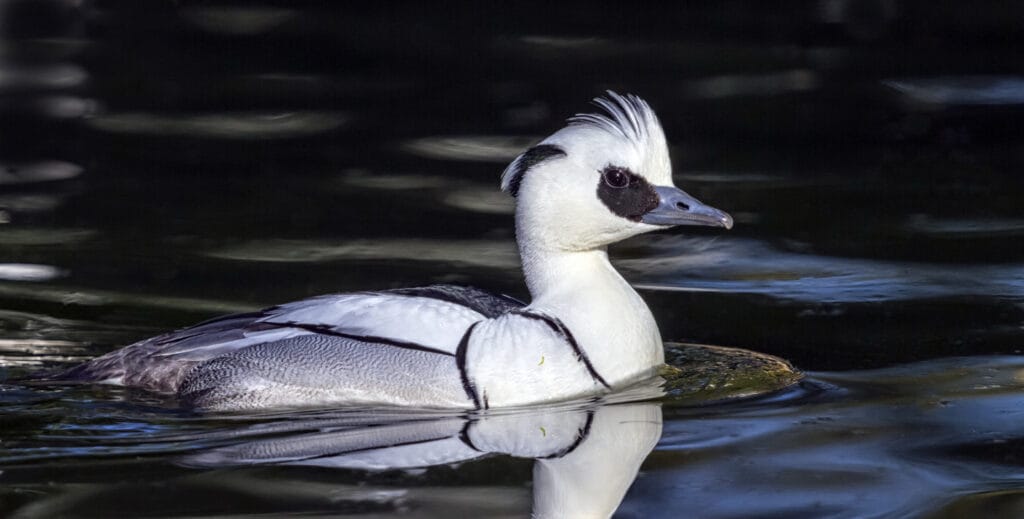
- Scientific name: Mergellus albellus
- Length: 16 to 17 inches
- Weight: 20 to 24 ounces
- Wingspan: 22 to 25 inches
The Smew, also known as the Small Eurasian Merganser, is a species of diving duck with a slicked-back white-and-black mohawk. It’s the only living member of its family, with the rest having gone to extinction several decades ago.
Author Note: Elegant and sophisticated, the Smew lives in northern Europe and parts of Asia, as well as the western Aleutian Islands in Alaska. It can be spotted in fish-rich lakes and slow rivers.
The drake Smew has an unmistakable “panda” appearance with its black-and-white patterning. Females and immatures are gray with chestnut to dark brown foreheads and crowns.
12. Purple-crested Turaco
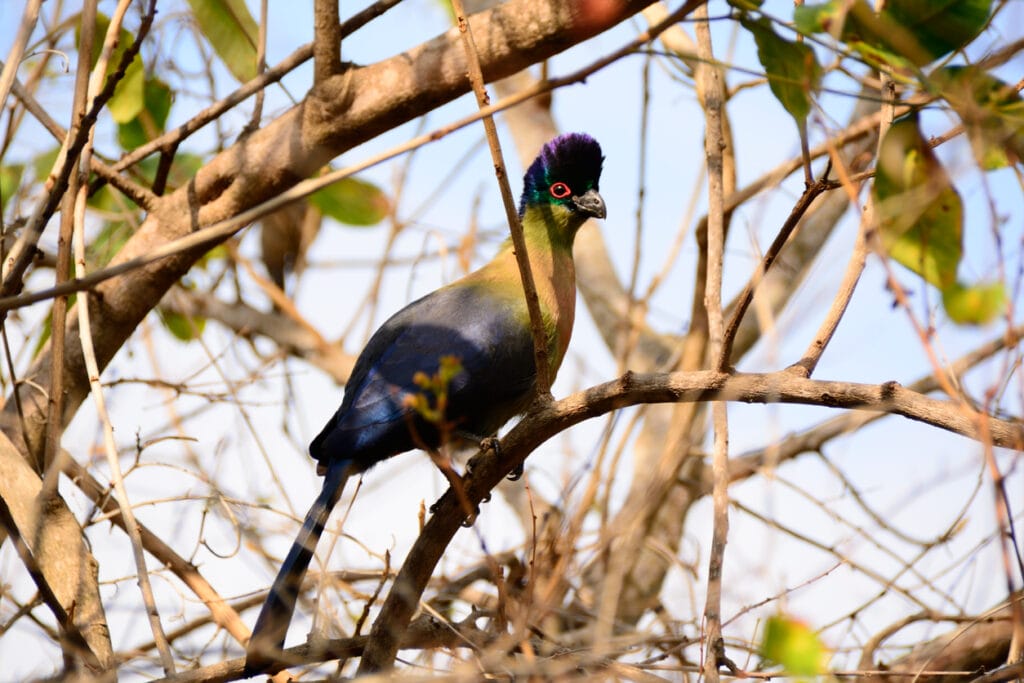
- Scientific name: Tauraco porphyreolophus
- Length: 16.5 to 18 inches
- Weight: 8 to 14 ounces
- Wingspan: 22 to 25 inches
The Purple-crested Turaco is the National Bird of Eswatini (formerly Swaziland). With its regal looks and styled-to-perfection mohawk, I’m honestly not surprised—it’s indeed a majestic bird, deserving of its title!
Native to South Africa, the Purple-crested Turaco is an iridescent bird with blue, olive, green, and deep purple undertones. It has a rose-pink upper back, grayish-blue wings, and a blue-black rump. Its mohawk is an iridescent dark violet-purple—a color punk rockers would surely kill for!
The Purple-crested Turaco mostly lives in evergreen forests and moist woodlands. Its diet primarily consists of fruit and berries.
13. Great Curassow
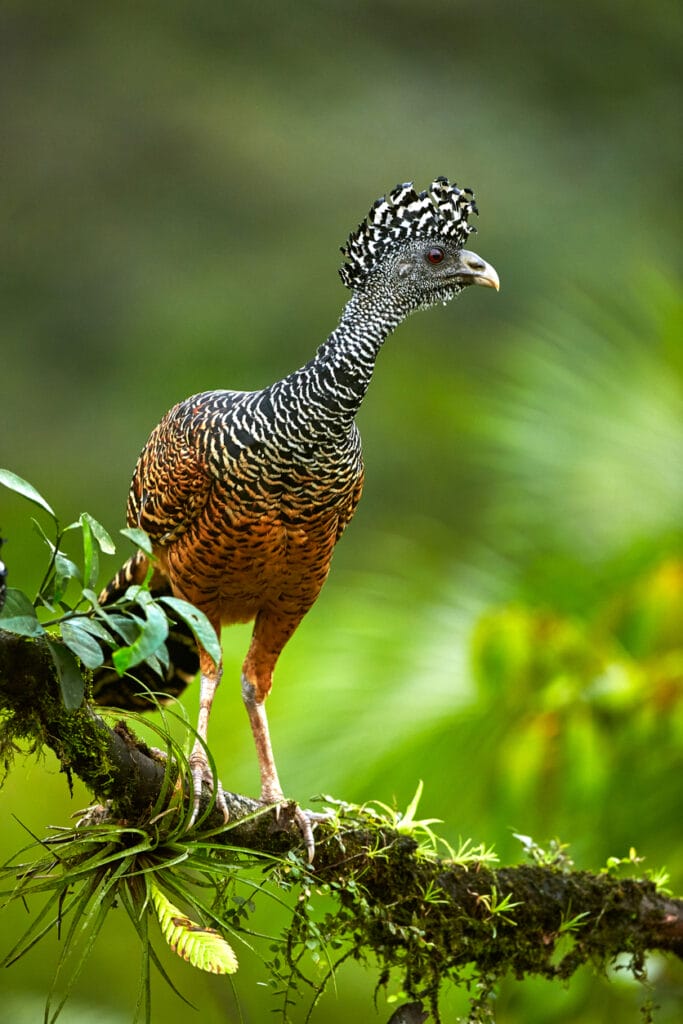
- Scientific name: Crax rubra
- Length: 31 to 39 inches
- Weight: 108 to 150 ounces
- Wingspan: 15.7 inches
The Great Curassow is a large pheasant-like bird that’s mostly black in appearance. If it wasn’t for its silly hairdo, I’d be intimidated. Instead, I find myself trying to imitate the look on my Friday-night outings. This bird pulls it off brilliantly!
This species of bird live in Central America and Mexico in groups of around 10 to 15. It’s usually seen on the forest floor, foraging for fallen fruits, berries, and seeds. It’s not picky, though; if it can’t find tasty berries, it’ll feed on insects or small animals.
The Great Curassow is a vulnerable species. Before its conservation status was changed, this bird was hunted for sport. Paired with habitat loss and fragmentation, this species has declined rapidly over the course of several short years.
14. White-Crested Helmetshrike
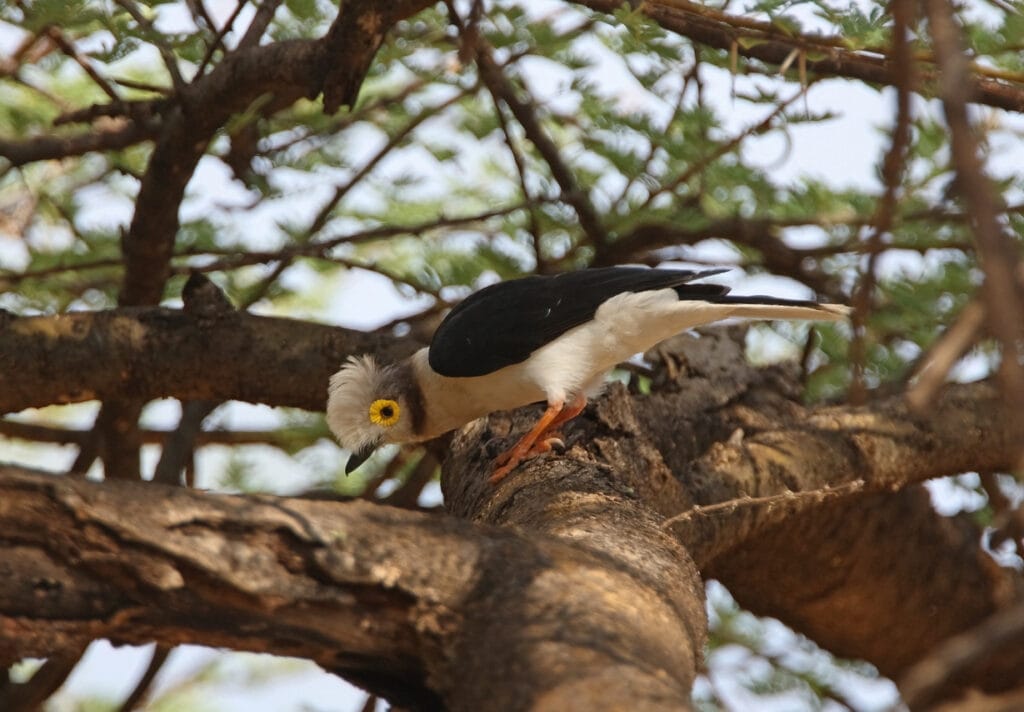
- Scientific name: Prionops plumatus
- Length: 9 to 9.8 inches
- Weight: 1.1 to 1.3 ounces
- Wingspan: 10 to 13 inches
With their sunflower-like eye-wattles and fluffy white mohawks, the White-crested Helmetshrike is one of the more unique-looking birds out there.
Author Note: Found in small, active parties, this species of bird resides in subtropical or tropical dry forests, moist savannas, and dry shrubland. They’re relatively widespread across sub-Saharan Africa, and particularly common in Mozambique, Zimbabwe, and Botswana.
These birds mainly feed on moths and caterpillars, but they won’t say no to the occasional lizard or spider.
Conclusion
There you have it, folks; some of the most awesome-looking birds with mohawks that exist today. Some of these birds pull off the mohawk look so well that I won’t be surprised if a hairdresser copied the look—color and all!
We hope you enjoyed our guide on the most beautiful birds with mohawks. So, who’s your favorite mohawk-wearing bird?
FAQ
The Southern Cassowary has a horn that looks like a mohawk and the Hornbill has a keratin made horn as well.
Some penguin and crane species have floppy crests on their heads.
The Northern Cardinal does have a large crest but I think it covers more of the head than a mohawk would.




